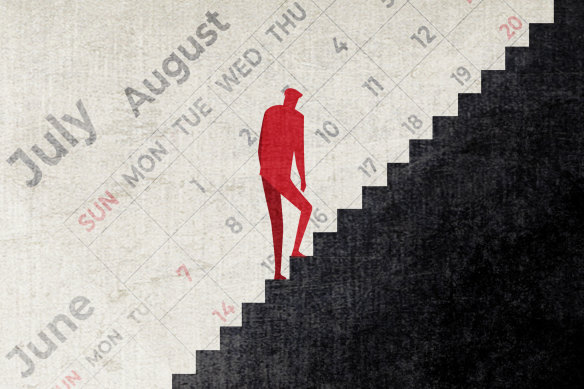This was published 4 months ago
How to avoid burnout once you hit the mid-year slump
By Nell Geraets
For many, the mid-year mark can feel like a roadblock. You’ve made it through six months of hard work and are now technically on the other side, yet the end of the year could not seem further away.
According to a 2023 global workplace report by analytics company Gallup, 47 per cent of Australian workers experienced daily stress, one of the highest stress rates in the world.

Mid-year burnout is common, but there are ways to overcome it.Credit: Compiled by Monique Westermann
Furthermore, 67 per cent of women said they were “not engaged” with their work despite being physically present.
These are common symptoms of burnout, a term regularly bandied around workplaces, but often not fully understood. As we trudge past the mid-year point, how can we identify burnout, and what are some ways to overcome it?
What is burnout?
Burnout is a “bone-deep exhaustion where you’re emotionally drained, mentally overloaded, and unable to muster the enthusiasm to keep going”, says chief executive of Associated Employee Assistance Providers Dan Auerbach.

Burnout is a kind of “bone-deep exhaustion” that can leave you overwhelmed and lacking motivation at work.Credit: iStock
It’s usually associated with chronic stress caused by too many demands in the workplace. The World Health Organisation classified burnout as an occupational syndrome in 2019. However, it can also spill into people’s private lives, especially for parents and caregivers with extra responsibilities at home.
“It’s more than just being tired. It’s a feeling like you’ve got nothing left to give and that your efforts no longer have an impact. Unlike depression, you may feel burnt out in one area of your life, say at work, but feel fine in other parts,” Auerbach says.
Notably, burnout is different from general stress, says Australian Psychological Society president Dr Catriona Davis-McCabe. The latter is often situational and more easily reversed through proper sleep or stress management. Burnout, on the other hand, is a form of prolonged emotional, physical and mental exhaustion.
“People experiencing burnout are more likely to avoid engaging with others rather than being overly engaging, as with situational stress,” says Davis-McCabe.
Burnout can occur year-round, but Auerbach says Australians are particularly susceptible to it mid-year since it coincides with colder weather and minimal daylight.
“There’s also the stress of the end of the financial year. Others may be frustrated that New Year’s resolutions or business plans are not coming to fruition as quickly as they had hoped.”
How can I overcome it?
Honest communication with your bosses is vital when navigating burnout, says organisational psychologist and Deakin University lecturer Dr Sherrica Senewiratne. This includes asking for help or delegating tasks when feeling overwhelmed.
“Discuss how you can effectively divide tasks among other team members. It’s also important to discuss the lack of meaningfulness you experience in your job or any self-doubt in performing tasks which may contribute to burnout,” Senewiratne says. “Remember you can say ‘no’, but with a valid reason so that your manager knows you’re not slacking.”
Are you an employer? Here’s how you can help your employees avoid burnout
Employers should lead by example, says RMIT human resource analytics lecturer Dr Asanka Gunasekara.
“Create an organisational culture that employees can share, ask for support and help if they feel they cannot cope with the workload, or are not experiencing any enjoyment from work.”
Here are a few ways to do this, according to Gunasekara:
- Purposeful job crafting: “Understand what matters to employees. Design meaningful jobs that employees like to perform so that they experience a sense of fulfilment through the job.”
- Prioritise the health and wellbeing of employees: “Include wellbeing and burnout-related discussions in performance appraisal meetings.”
- Open and honest conversations: openly communicate about burnout or stress with employees and “include relevant questions in employee voice surveys” so that they can help frame future policies.
If you’re approaching a busy period, planning ahead can ensure you get tasks done in a timely, non-overwhelming manner. Senewiratne says this could be as simple as organising activities in advance for your children during school holidays so you can focus on work during the day.
Finally, prioritise self-care. “Remember you’re only human. You also need a break, so schedule a little activity for yourself, like 30 minutes of reading, exercise a few times a week, or having a glass of wine while you watch the newest rom-com on Netflix,” Senewiratne says.
Mindfulness and meditation can help ground your thoughts, she adds, and counsellors can offer additional professional support if burnout persists.
A holiday wasn’t enough, what do I do?
Many people tackle burnout by taking time off work, which allows them to unplug and unwind before returning with a refreshed mindset. However, some may find it impossible to switch off while away, distracted by non-stop work notifications or mental to-do lists.
“Before you go on holiday, spend some time writing down all your biggest wins. Then, reflect on how much you’ve achieved before you take a break and do a proper handover. Be clear about your availability during holidays,” Senewiratne says.
“Consider leaving your computer behind when you go on holiday, or you can easily switch off email and chat notifications on your phone so you don’t see any messages from work.”
Notably, Auerbach says burnout and the need for major life changes, such as a change in job, can initially feel similar, but they usually require different resolutions.
“Burnout often improves with rest, stress management and setting boundaries,” Auerbach says. “If you’ve tried taking breaks and setting boundaries, but you’re still miserable, it might be time to consider if your job or current situation aligns with your values and goals. Ongoing feelings of misalignment, or lack of purpose, may indicate a need for change rather than just burnout.”
Make the most of your health, relationships, fitness and nutrition with our Live Well newsletter. Get it in your inbox every Monday.